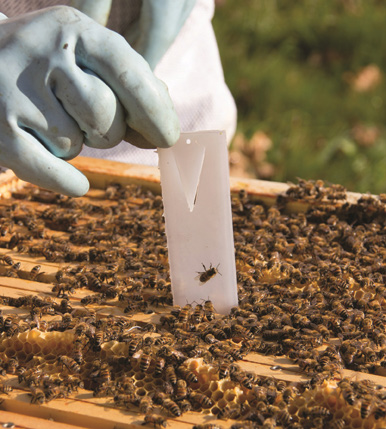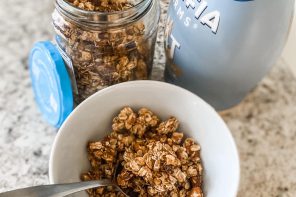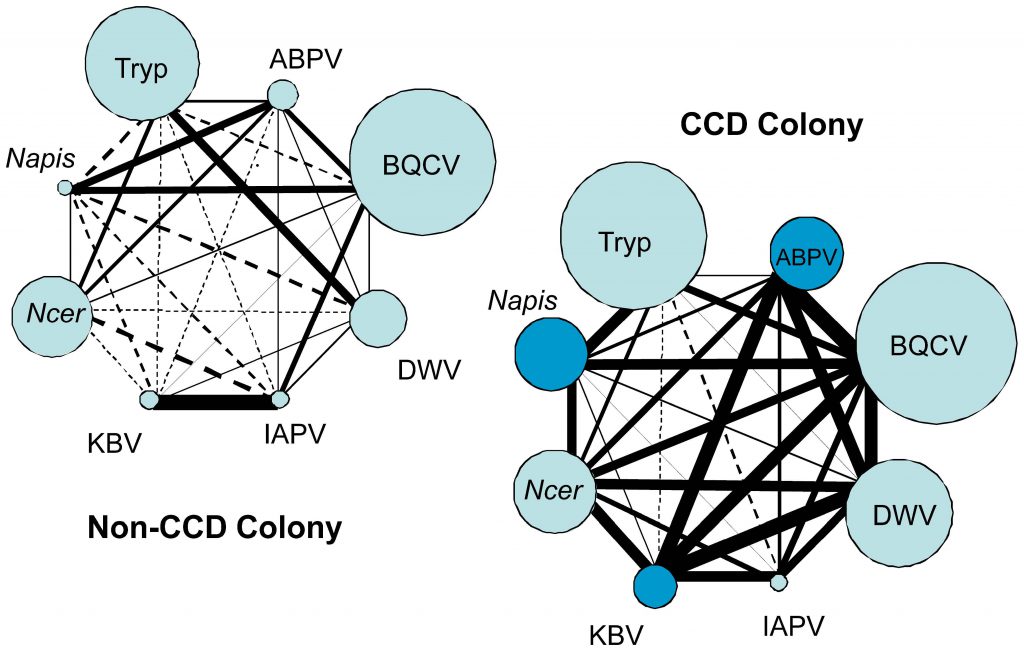By: Frank Rinkevich & David MacFawn
If you want to learn to be a good beekeeper, it is extremely important to learn about Varroa mites. You don’t have Varroa mites because you’re a bad beekeeper; you have Varroa mites because you are a beekeeper! Whether you’re a multi-generational beekeeper or a beginner, commercial manager or hobbyist, use “conventional” or “natural/organic” methods, Varroa will find a way to wreak havoc on your bees. There are few things more disheartening than seeing a strong honey bee colony wither and die because of uncontrolled Varroa populations.
Often times, miticides are used as the primary tool to manage Varroa populations, mostly due to their ease of use and effectiveness. It is easy to get into the routine of using the same miticide every year because “It worked in the past so it should keep working this year” and “If a little bit works, then a little more should work better.” However, this kind of approach to miticide use creates conditions that can lead to miticide resistance. In fact, that is exactly what happened with Apistan® (tau-fluvalinate) and CheckmiteTM (coumaphos) and why they are not widely used any more(1,2).
The development of miticide resistance is the expected evolutionary outcome of a selection event (miticide application) that leads to differential reproduction (dead Varroa don’t reproduce) in which their offspring possess the means for survival (miticide-resistance genes). Miticide resistance in Varroa is not unique or unusual as resistance to a diverse array of pesticides is very common in many arthropods(3).
Amitraz resistance in Varroa was first reported in the United States more than 20 years ago(4). Despite widespread amitraz use since then, there have been few reports of resistance in the USA in the scientific literature(5) and amitraz-control failures were mostly rare and anecdotal. It is our hypothesis that it is due to a few factors. Amitraz and its toxic breakdown product, N-(2,4-dimethylphenyl)-N-methylformamidine (DMPF), does not accumulate to extremely high concentration and prevalence in the wax in the manner that tau-fluvalinate and coumaphos do(6,7). The high concentration of tau-fluvalinate and coumaphos in wax provide constant conditions for strong selection of resistance. Amitraz tends to reach high concentration in the colony when the strips are applied and declines rapidly after they are removed. Under this scenario, amitraz does not continuously select for resistance. However, constant amitraz application where strips are removed and immediately replaced throughout the year may provide adequate conditions to select for amitraz resistance. It is possible that widespread amitraz resistance has not developed because there may be a trade-off or a fitness cost to amitraz resistance, especially in the absence of amitraz exposure. Fitness costs can manifest in lower reproduction, reduced survivorship, altered behavior, or a variety of other detrimental conditions. Fitness costs have been observed in amitraz-resistant cattle ticks(8), so a similar condition in amitraz-resistant Varroa is plausible. These statements are still just hypotheses and current and future research will provide much needed answers to the how and why of amitraz resistance.
Our interest in amitraz resistance in Varroa began about five years ago after having many conversations with beekeepers who had the same recurring experience that amitraz did not provide adequate Varroa control as it used to. There were a number of explanations about why amitraz was becoming ineffective, but the only consistent explanation was that amitraz resistance was developing in Varroa. Amitraz resistance was first reported in the USA more than 20 years ago(4) so it is likely becoming more widespread after years of use.
Beginning in the Spring of 2019, two different approaches were used to detect amitraz resistance. The first approach was to test for amitraz toxicity using pure amitraz in the glass-vial bioassay(4). Small jars (20 mL) were treated with different concentrations of pure amitraz to determine the LC50 (the concentration that is lethal to 50 percent of the population or the concentration that has a 50/50 chance of killing an individual Varroa mite). This approach allowed for toxicological comparison between Varroa populations. The second approach was to perform the Apivar® efficacy test in which a sample of bees are exposed to a square of Apivar® in a plastic container and the number of Varroa on those bees that survive the treatment indicates if those Varroa are resistant or susceptible(9). By using these two complimentary methods, we determined that reduced Apivar® efficacy was due to reduced amitraz sensitivity as determined from the glass-vial bioassay, thus confirming that reduced Apivar® efficacy is due to amitraz resistance(10). This is an important observation because it demonstrates that resistance is due to the active ingredient of pure amitraz, so it is unlikely that product formulation is a factor. In that first year of limited sampling, we found that most beekeeping operations had low to moderate amitraz resistance and only one operation was experiencing a bona fide control amitraz failure at the colony level.
Amitraz resistance monitoring was a large part of our research efforts in 2020 and 2021. While restrictions on research travel during the COVID-19 pandemic may have dampened our research efforts, it was an opportunity for innovation which dramatically improved the scope of our monitoring efforts. Amitraz resistance monitoring kits were shipped free of charge to beekeepers, apiary inspectors, and scientists who were interested in performing the test. The results and Varroa samples were sent back in the mail. We were able to double the number of apiaries and colonies sampled each year so that after three years of monitoring, we have worked with 44 beekeepers in 62 apiaries for a total of 674 colonies sampled. Work will continue with this expanded amitraz-resistance monitoring network in 2022 and our goals are to cooperate with 50 beekeepers across 70 apiaries and sample 1,000 colonies. It’s an ambitious goal but entirely feasible with external cooperators performing resistance monitoring with kits we will provide in concert with on-site sampling. With this abundance of data, we can start to make well-supported trends and observations that we hope to publish in the Summer of 2022.
Despite a number of alternative explanations for why amitraz applications fail to control Varroa, amitraz resistance is the most consistent factor in Varroa control failures. In nearly every instance of where beekeepers reported that amitraz application failed to control Varroa, the Varroa from those apiaries showed low levels of Apivar® efficacy.
Another interesting observation is that amitraz resistance varies from colony to colony within an apiary. For example, out of a sample of 10 colonies within an apiary, five may have no amitraz resistance (i.e., 100% Apivar® efficacy), three may have low levels of resistance, and two may have high levels of resistance. This is mostly consistent with a common anecdote from beekeepers where they said, “The treatment worked in most colonies, but there were a few where it didn’t work at all.” These “islands of resistance” may be due to 1) founder effect where the Varroa population within the colony is derived from a small initial Varroa population which included a few amitraz-resistant individuals, or 2) mutations that confer amitraz resistance arise spontaneously and independently in Varroa populations in each colony.
We hope to provide answers to these questions through a collaboration with Arian Avalos, who is the geneticist at our lab. We are sequencing nearly 500 individual Varroa genomes to identify DNA markers and determine the population genetics of amitraz-resistant Varroa. We hope this research will be published later in 2022. Some beekeepers ascribe the colony-to-colony variation in amitraz resistance to application error. While application error tends to be very infrequent, it is possible. In our experience, the most common miticide misuse is using only one strip per colony and making efficacy observations before the treatment is completed. It is understandable that application costs may result in only one strip used per colony, but it’s a much better economic strategy to invest in a proper treatment program than replacing a colony that was lost due to high Varroa infestation. Amitraz does not act instantaneously upon exposure at the colony level, and it takes a few brood cycles to control emerging Varroa that were under capped brood when strips were first applied. It is important to wait until the end of the treatment period to make a final assessment about treatment efficacy. Your patience will be rewarded!
Preliminary results indicate that miticide rotations are another valuable strategy to impede or overcome miticide resistance. In 2020, we worked with a number of beekeepers who had amitraz-resistant Varroa. After discussing the results, many of them used oxalic acid vapor on their amitraz resistant Varroa and documented the treatments and efficacy. When we went back to those apiaries in 2021 in hopes of studying the amitraz-resistant Varroa populations, we were unable to identify any amitraz-resistant Varroa in nearly every instance. The theory behind this phenomenon is that the probability of developing resistance to any single miticide is very low (e.g., 0.001%). Therefore, the probability of developing resistance to two miticides is essentially zero (e.g., 0.001% x 0.001% = 0.000001%). In fact, large-scale multi-state beekeepers that utilize amitraz with an organic acid or thymol treatment experienced reduced colony losses(11). The effectiveness of miticide rotations is important to beekeepers who may have amitraz-resistant Varroa because a non-amitraz treatment may provide adequate control and allow the colony to survive rather than euthanizing the colony to prevent the spread of amitraz-resistant Varroa. However, much more work is needed in this area to make more confident recommendations.
Miticides should not be considered a silver bullet for all of your Varroa ailments. Rather, miticides should be used as part of a multifaceted Varroa management program. Using different approaches build redundancy in the system to ensure that if one strategy fails, another will be there to ensure efficacy. Selective breeding efforts and investigations of naturally surviving honey bee colonies have identified a number of hygienic behaviors honey bees may utilize to control Varroa(12). Overwintering of honey bees at indoor storage facilities can take advantage of the brood break that is induced by cold temperatures while modulating carbon dioxide levels and fumigating with formic acid or oxalic acid can further reduce Varroa levels(13). Caging queens or splitting colonies to induce brood breaks are effective strategies to slow down Varroa reproduction. Screened bottom boards and trapping Varroa in drone brood may also reduce Varroa populations.
To be good product stewards, it is imperative that miticides are used according to the labelled instructions to provide adequate control and reduce the probability of resistance development. In the case of Apivar®, that means one strip for every five frames covered with bees, strips placed in the brood area or cluster, and leave strips in for at least 42 days and no longer than 56 days. Refer to the label for more detailed instructions. Taking notes on Varroa infestation before and after treatment will document and quantify efficacy. The loss of miticide efficacy due to resistance is a squandering of technology for which our honey bees will suffer the consequences.
If you are interested in participating in the amitraz-resistance monitoring program in 2022, please contact me at Frank.Rinkevich@usda.gov with your contact information and the amount of supplies you are requesting. I will ship supplies, protocols, and datasheets for you to test colonies at your apiaries (10 colonies/apiary). At the end of the test, you simply mail me the datasheet and Varroa samples that you collected from the test in a prepaid mailer. We will go over the results with you by the next day and discuss the potential efficacy of amitraz treatments. I look forward to another year of amitraz-resistance monitoring and working with all of you in the effort.
Mention of trade names or commercial products in this publication is solely for the purpose of providing specific information and does not imply recommendation or endorsement by the U.S. Department of Agriculture.
USDA is an equal opportunity provider and employer.
References
1. S. J. Martin, Acaricide (pyrethroid) resistance in Varroa destructor. Bee World 85, 67-69 (2004).
2. J. S. Pettis, A scientific note on Varroa destructor resistance to coumaphos in the United States. Apidologie 35, 91-92 (2004).
3. M. Whalon, D. Mota-Sanchez, R. Hollingsworth, Global pesticide resistance in arthropods. (CABI, Cambridge, MA, 2008), pp. 166.
4. P. J. Elzen, J. R. Baxter, M. Spivak, W. T. Wilson, Control of Varroa jacobsoni Oud. resistant to fluvalinate and amitraz using coumaphos. Apidologie 31, 437-441 (2000).
5. D. Sammataro, P. Untalan, F. Guerrero, J. Finley, The resistance of varroa mites (Acari:Varroidae) to acaricides and the presense of esterase. Intl. J. Acaraol. 31, 67-74 (2005).
6. C. A. Mullin et al., High levels of miticides and agrochemicals in North American apiaries: implications for honey bee health. PLoS ONE 5, e9754 (2010).
7. K. S. Traynor et al., In-hive Pesticide Exposome: Assessing risks to migratory honey bees from in-hive pesticide contamination in the Eastern United States. Scientific Reports 6, 33207 (2016).
8. S. W. Corley et al., Mutation in the RmβAOR gene is associated with amitraz resistance in the cattle tick Rhipicephalus microplus. Proceedings of the National Academy of Sciences 110, 16772-16777 (2013).
9. P. D. Vu, L. C. Rault, L. J. Jenson, J. R. Bloomquist, T. D. Anderson, Voltage-gated chloride channel blocker DIDS as an acaricide for Varroa mites. Pestic. Biochem. Physiol. 167, 104603 (2020).
10. F. D. Rinkevich, Detection of amitraz resistance and reduced treatment efficacy in the Varroa Mite, Varroa destructor, within commercial beekeeping operations. Plos one 15, e0227264 (2020).
11. A. I. Haber, N. A. Steinhauer, D. vanEngelsdorp, Use of chemical and nonchemical methods for the control of Varroa destructor (Acari: Varroidae) and associated winter colony losses in US beekeeping operations. J. Econ. Entomol. 112, 1509-1525 (2019).
12. F. Mondet et al., Honey bee survival mechanisms against the parasite Varroa destructor: a systematic review of phenotypic and genomic research efforts. Int. J. Parasitol. 50, 433-447 (2020).
13. R. M. Underwood, R. W. Currie, Indoor winter fumigation of Apis mellifera (Hymenoptera: Apidae) colonies infested with Varroa destructor (Acari: Varroidae) with formic acid is a potential control alternative in northern climates. J. Econ. Entomol. 97, 177-186 (2004).







